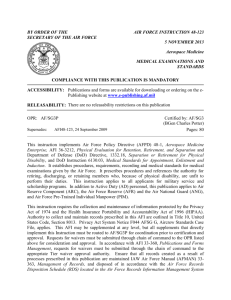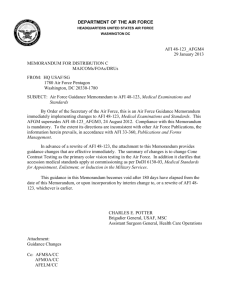General Flight Operating procedure
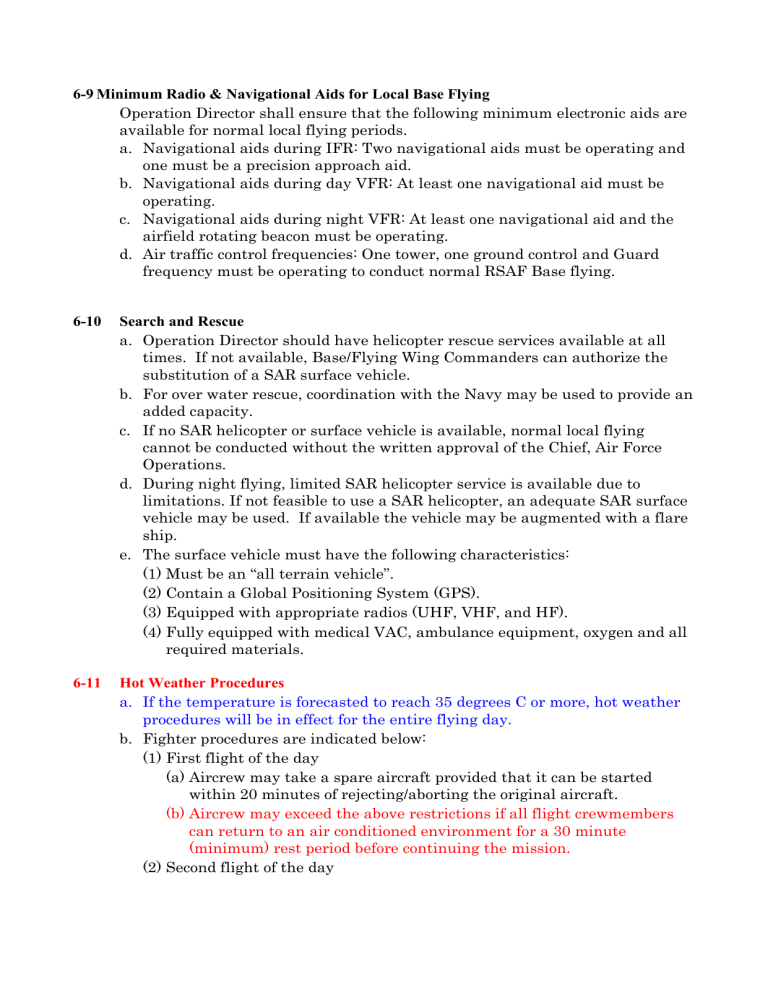
6-9 Minimum Radio & Navigational Aids for Local Base Flying
Operation Director shall ensure that the following minimum electronic aids are available for normal local flying periods. a. Navigational aids during IFR: Two navigational aids must be operating and one must be a precision approach aid. b. Navigational aids during day VFR: At least one navigational aid must be operating. c. Navigational aids during night VFR: At least one navigational aid and the airfield rotating beacon must be operating. d. Air traffic control frequencies: One tower, one ground control and Guard frequency must be operating to conduct normal RSAF Base flying.
6-10 Search and Rescue a.
Operation Director should have helicopter rescue services available at all times. If not available, Base/Flying Wing Commanders can authorize the substitution of a SAR surface vehicle. b.
For over water rescue, coordination with the Navy may be used to provide an added capacity. c.
If no SAR helicopter or surface vehicle is available, normal local flying cannot be conducted without the written approval of the Chief, Air Force
Operations. d.
During night flying, limited SAR helicopter service is available due to limitations. If not feasible to use a SAR helicopter, an adequate SAR surface vehicle may be used. If available the vehicle may be augmented with a flare ship. e.
The surface vehicle must have the following characteristics:
(1) Must be an “all terrain vehicle”.
(2) Contain a Global Positioning System (GPS).
(3) Equipped with appropriate radios (UHF, VHF, and HF).
(4) Fully equipped with medical VAC, ambulance equipment, oxygen and all required materials.
6-11 Hot Weather Procedures a.
If the temperature is forecasted to reach 35 degrees C or more, hot weather procedures will be in effect for the entire flying day. b.
Fighter procedures are indicated below:
(1) First flight of the day
(a) Aircrew may take a spare aircraft provided that it can be started within 20 minutes of rejecting/aborting the original aircraft.
(b) Aircrew may exceed the above restrictions if all flight crewmembers can return to an air conditioned environment for a 30 minute
(minimum) rest period before continuing the mission.
(2) Second flight of the day
(a) The aircrew may take a spare aircraft under the conditions of paragraph (1) above, only if the rejection or abort occurs prior to taxiing. c. Hot weather procedures for transports, helicopters and trainers should be included in Aircraft SOP.
6-12 High Wind Conditions a.
High wind conditions create a dangerous situation for parachute landing and range safety. Because of ejection seat limitations, flight operations in the local flying areas or training range should be suspended during periods of high wind conditions. b.
Forecast of steady surface winds of 35 knots during the day, or 30 knots at night, should be justification to cancel air to surface range operations.
Winds of this magnitude should be evaluated with other factors for suspension of all flying.
6-13 Functional Check Flight (FCF) Aircrew Restrictions a.
No one shall fly as a passenger on an FCF flight. b.
An aircrew member shall be FCF qualified by local procedures, and as a minimum, have completed an MQT program for the type of aircraft.
7-1 Helicopters a.
Takeoffs and landings from unfamiliar areas or sites shall not be performed without approval of the Flying Wing Commander. b.
If an approved mission requires landing in an extremely sandy or area with salt water, an entry must be made in the aircraft forms, and maintenance must be informed.
7-2 Enroute Altitudes a.
Altitudes assigned by air traffic control must be flown. b.
If not assigned as filed, the altitude assigned must be maintained until approval to change is received. c.
Enroute, fly no lower than, or accept an assigned altitude lower than, the appropriate Minimum IFR altitude. d.
When in uncontrolled airspace, the pilot is solely responsible for traffic separation and obstruction clearance. e.
If in an area with no published minimum IFR altitudes, fly no lower than
2000-ft above the highest obstacle within 10 nm of planned course. f.
Dual engine helicopters shall not takeoff if the above minimum altitudes cannot be maintained on one engine.
7-3 Helicopter altitude limits
(a) Low altitude limits for helicopters vary depending on speed and hover status.
(b) Helicopters shall limit their altitude to a minimum of 100 ft above the ground, 200 ft above the water, when enroute at cruising speed.
(c) Minimum altitude shall be increased to avoid vertical obstructions in conditions of reduced visibility. Pilots must be aware of their positions and the height of vertical obstructions, that might be encountered by reference to current maps.
Area
Known Area
Unknown Area
Water
Table 7-2
SAR or Operational Flight Minimums
Radar Altimeter Must Be Operational
Day Night
500 ft 500 ft
(In a corridor 1 nm each side of the track
500 ft
170 ft
500 ft
200 ft
(With cruise height mode)
Night with NVG
170 ft
(With a moon)
400 ft
(Without a moon)
400 ft
200 ft
(With cruise height mode)
Helicopter Normal and Alert Duty Crew Rest Limits
Maximum Flight Duty Period
Normal Duty
Minimum Crew Rest Period
12 hours maximum flight duty period 12 hours minimum crew rest period
Alert Duty (10 minute Stand-by in squadron requires crew rest prior to next flight after Stand-by duty ends).
12 hours maximum standby duty period, if required.
If launched, may perform maximum of:
(1) 4 missions or
(2) 6 hrs flying time (which ever occurs first)
12 hrs minimum crew rest period after 12 hr alert duty
Alert Duty (1 hour Stand-by at home may or may not require crew rest prior to the next flight after Stand-by duty ends).
24 hours maximum standby duty period, if required.
If launched, may perform maximum of:
(1) 4 missions or
(2) 6 hrs flying time (which ever occurs first)
12 hrs minimum crew rest period after 12 hr or 24 hr alert duty only if:
(1) The period for 8 hrs of uninterrupted rest is interrupted by an official duty, which includes receiving an official telephone call.
(2) The aircrew flew a mission or performed any other official duty except receiving an official telephone call outside of the period of 8 hrs of uninterrupted rest.
Examples:
(1) Aircrew member who flies in the morning cannot assume alert duty until he has 12-hrs crew rest.
(2) Aircrew member who had crew rest prior to a
12 hr or 24 hr 1 hr Stand-by, during which his
8-hr rest was not interrupted, has crew rest to fly when Stand-by duty is over.
(3) Aircrew member on 1 hr Stand-by duty who has his 8 hr rest interrupted must have crew rest before flying.
Notes:
1. Refer to Table 3-1 for maximum flight duty period limits.
2. 12-hr crew rest is required prior to performing Alert Duty since the aircrew member may have to fly.
Table D-3



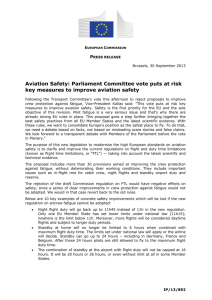



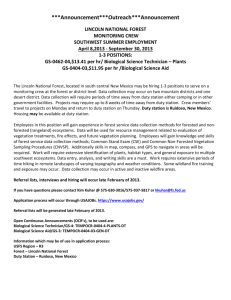
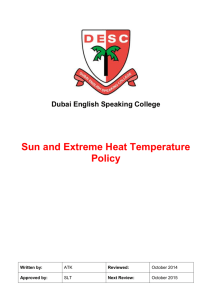
![(NPD-60) []](http://s3.studylib.net/store/data/007320126_1-47edb89d349f9ff8a65b0041b44e01a8-300x300.png)
